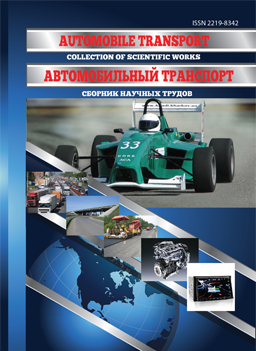Increasing the efficiency of the automotive generator due to active rectification
DOI:
https://doi.org/10.30977/VEIT.2024.25.0.1Keywords:
mild hybrid electric vehicle, start-stop system, automotive generator, active rectifier system, three-phase bridge rectifier, synchronous rectifierAbstract
Problem. Increasing fuel economy requirements for modern vehicles lead to an increase in their electrification. The rise in the number of electrical systems leads to a higher load on the electrical power supply system, with the vehicle's power load reaching 2-3 kW. Leading automobile companies have begun serial production of vehicles with the new 12/48 V power supply voltage standard. The traditional alternator used today is a synchronous alternator, and rectifier diodes are used to convert the generated AC to DC to charge the battery, which is inefficient. A study of losses in an automobile alternator shows that the diode rectifier creates a significant portion of the machine's losses at low speeds, resulting in increased fuel consumption. The solution to this problem is to use a synchronous rectifier to replace traditional rectifier diodes, thus improving the efficiency of the AC/DC rectifier. Goal: To improve the economic and environmental characteristics of a mild hybrid vehicle through the use of a synchronous two-semi-periodic rectifier with a midpoint in the car generator. Methodology: Analytical methods are used to calculate energy losses on diodes and in the phase windings of the generator when employing a two-semiperiod rectifier with a midpoint, compared to a bridge rectifier. Results: The structure, functions, and operation modes of the synchronous rectification system are considered. The effect of synchronous rectification on the generator efficiency of a mild hybrid vehicle is analyzed. It was determined which configurations of synchronous rectification are more effective from the standpoint of energy saving and under which operating conditions. It was determined that in a two-semiperiod rectifier with a midpoint, compared to a bridge rectifier, there will be the same heating of the phase windings and 2 times fewer losses on the diodes. Practical value: A version of the bridge synchronous rectification system of the 48 V generator for a mild hybrid vehicle using MOSFET transistors and specialized control IC is proposed. A synchronous rectification system and its circuit implementation for a 12 V generator based on a two-semi-periodic rectifier scheme with a midpoint is proposed, which allows increasing the energy efficiency and economy of the automobile generator.
References
Taoudi, A., Haque, M., Luo, C., Strzelec, A. et al. (2001). Design and Optimization of a Mild Hybrid Electric Vehicle with Energy-Efficient Longitudinal Control. SAE Int. J. Elec. Veh. 10 (1): 55-78, 2021. https://doi.org/10.4271/14-10-01-0005.
Sarafianos, Dimitrios & Logan, Thomas & Mcmahon, Richard & Flack, T.J. & Pickering, Stephen. (2014). Alternator loss breakdown and use of alternative rectifier diodes for improvement of vehicle electrical power system efficiency. 502-507. https://doi.org/10.1109/EPEPEMC.2014.6980543
Mürken, Michael & Kübel, D & Kurz, A & Thanheiser, Andreas & Gratzfeld, P. (2018). Fault analysis of automotive claw pole alternator rectifier diodes. https://doi.org/10.1109/ESARS-ITEC.2018.8607641.
Mild Hybrid Electric Vehicle (MHEV) – examples (2020). https://x-engineer.org/mild-hybrid-electric-vehicles-mhev-examples/
Mahmood, Omar & Wan Hasan, W. & Ismail, Luthffi & Shafie, Suhaidi & Azis, Norhafiz & Norsahperi, Nor Mohd Haziq. (2022). Optimization Approaches and Techniques for Automotive Alternators: Review Study. Machines. 10. 10.3390/machines10060478.
Chen, Jyh-Wei & Tran, Thanh Nhat Trung. (2019). Design of Low-Cost Voltage Sensing Method of Three-phase Synchronous Rectifier with High-Efficiency for Automotive Alternator. 1-6. https://doi.org/10.1109/ITEC-AP.2019.8903894.
Hidaka, Yuki. (2021). Novel coupled analysis methods of automotive alternators considering synchronous rectification circuit. COMPEL - The international journal for computation and mathematics in electrical and electronic engineering. ahead-of-print. https://doi.org/10.1108/COMPEL-09-2020-0319.
K. S. Kao et al. (2018). A high efficient synchronous rectifier for next generation automotive alternator applications. International Conference on Electronics Packaging and iMAPS All Asia Conference (ICEP-IAAC), Mie, Japan, 2018, pp. 391-395. https://doi.org/10.23919/ICEP.2018.8374330.
Rees, Stephan & Ammann, Ulrich. (2003). A smart synchronous rectifier for 12 V automobile alternators. 1516 - 1521 vol.4. https://doi.org/10.1109/PESC.2003.1217684.
International Rectifier. (2018). HEXFET Power MOSFET: IRFP4468PBF. https://www.infineon.com/dgdl/Infineon-IRFP4468-DataSheet-v01_01-EN.pdf?fileId=5546d462533600a40153562c73472019
Diodes Incorporated. (2021). Secondary side synchronous rectification controller. APR348, Document number: DS42016 Rev. 5 - 2. https://www.diodes.com/assets/Datasheets/APR348.pdf
International Rectifier. (2013). Advanced smartrectifierTM control IC: IR11672AS. https://www.infineon.com/dgdl/ir11672aspbf.pdf?fileId=5546d462533600a4015355c455561653
International Rectifier. (2011). Dual smart rectifier driver IC: IR1168S. https://www.infineon.com/dgdl/ir1168.pdf?fileId=5546d462533600a4015355c467fa1658
Adnaan Lokhandwala. (2016). Design of Secondary-Side Rectification using IR1168 Dual SmartRectifier™ Control IC. Application Note AN-1139. International Rectifier. https://www.infineon.com/dgdl/an-1139.pdf?fileId=5546d462533600a40153559a0fdf10d9
Downloads
Published
How to Cite
Issue
Section
License
Copyright (c) 2024 Олександр Дзюбенко, Володимир Двадненко

This work is licensed under a Creative Commons Attribution 4.0 International License.
Автори, які публікуються у цьому журналі, погоджуються з наступними умовами:
1. Автори залишають за собою право на авторство своєї роботи та передають журналу право першої публікації цієї роботи на умовах ліцензії Creative Commons Attribution License, котра дозволяє іншим особам вільно розповсюджувати опубліковану роботу з обов'язковим посиланням на авторів оригінальної роботи та першу публікацію роботи у цьому журналі.
2. Автори мають право укладати самостійні додаткові угоди щодо неексклюзивного розповсюдження роботи у тому вигляді, в якому вона була опублікована цим журналом (наприклад, розміщувати роботу в електронному сховищі установи або публікувати у складі монографії), за умови збереження посилання на першу публікацію роботи у цьому журналі.
3. Політика журналу дозволяє і заохочує розміщення авторами в мережі Інтернет (наприклад, у сховищах установ або на особистих веб-сайтах) рукопису роботи, як до подання цього рукопису до редакції, так і під час його редакційного опрацювання, оскільки це сприяє виникненню продуктивної наукової дискусії та позитивно позначається на оперативності та динаміці цитування опублікованої роботи.








